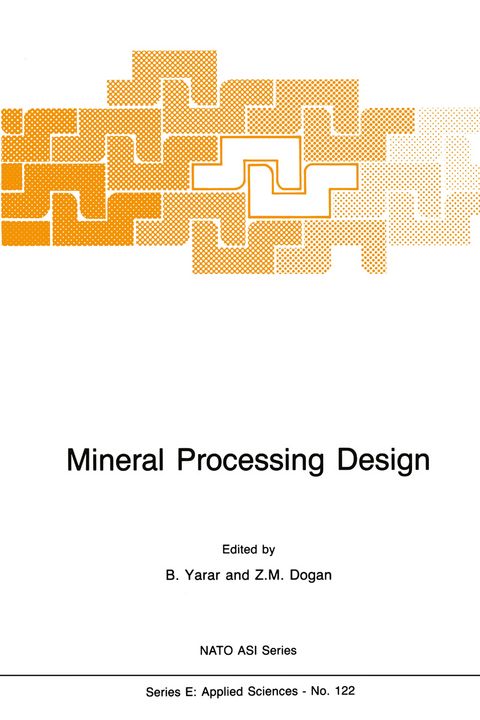
Mineral Processing Design
Kluwer Academic Publishers (Verlag)
978-90-247-3472-6 (ISBN)
- Titel z.Zt. nicht lieferbar
- Versandkostenfrei innerhalb Deutschlands
- Auch auf Rechnung
- Verfügbarkeit in der Filiale vor Ort prüfen
- Artikel merken
Foreword.- 1 — Applied Mineralogy in Ore Dressing.- 1. Introduction.- 2. Studies On Uncrushed Ores.- 3. Studies of Crushed Mill Products.- 4. Applied Mineralogy in Circuits Treating Volcanogenic Ores.- 5. Examples of Beneficiation Problems Explained by Mineralogical Studies.- 6. Equipment for Performing Mineralogical Analysis.- 7. Methods of Mineral Identification.- 8. Methods of Determining Mineral Compositions.- 9. Methods of Determing Mineral Quantities.- 10. Methods of Determining Mineral Liberation and Size Distributions.- 11. Presentation of Data.- References.- 2 — Chemistry osf Sulfide Mineral Flotation.- 1. Introduction.- 2. Modulation of Collector Coating.- 3. Electrochemical Studies.- 4. Silver Sulfide Electrode and Its use in Controlling Flotation of an Oxidized Lead-Zinc Ore.- References.- 3 — Coal Flotation.- 1. Introduction.- 2. Structure and Composition of Coal, Affecting Coal Flotation.- 3. Operational Factors Related to Coal.- 4. Cost of Coal Preparation Plant.- 5. Conclusion.- References.- 4 — Gravity Concentration Methods.- 1. Introduction.- 2. Principles.- 3. Mechanism of Concentration.- 4. Unit Processes.- 5. Testing for Gravity Concentration.- 6. Plant Operations.- References.- 5 — Processing of Mineral Ores by Modern Magnetic Separation Techniques.- 1. Introduction.- 2. Particle Entrapment Devices.- 3. The Kolm-Marston ‘High Gradient’ Magnetic Separation.- 4. Particle Deflection Devices.- 5. Prototype OGMS Systems.- 6. Projected Future Developments.- References.- 6 — The Methodology of Froth Flotation Testwork.- 1. Introduction.- 2. Objectives and Evaluation Criteria.- 3. Mineral Appraisal.- 4. Types of Flotation Testwork.- 5. Statistical Aspects of Flotation Testwork.- 6. Model Development and Optimization.- References.- 7 —Mineral Processing Flowsheet Development.- 1. Introduction.- 2. Objectives of Metallurgical Testing.- 3. Choice of Sample(s) for Metallurgical Testing.- 4. Laboratory Testwork Programming.- 5. Execution of the Laboratory Batch Testwork.- 6. Cycle Tests.- 7. Complementary Testwork for Design Purposes.- 8. Pilot Plant Testwork.- 9. Final Recommendations.- References.- 8 — Mass Balance Equilibration.- 1. The Origin and Classification of Errors.- 2. The Need for Systematic Approach to Data Validation.- 3. Principles of Mass Balance Computation.- 4. Application to a Grinding-Classification Process.- 5. Extended Balance Equilibration.- References.- 9 — Concentrating Plant Design-Capital and Operating Costs.- 1. Concentrating Plant Design.- 2. Capital Costs.- 3. Operating Costs.- References.- 10 — Simulation in Mineral Processing.- 1. Introduction.- 2. Methodology.- 3. Experimental Example.- 4. Conclusion.- References.- 11 — Slurry Pipeline Transport of Minerals and Coal.- 1. Introduction.- 2. Technical Aspects of Slurry Pipeline System Components.- 3. Hydraulics of Slurry Flow in Pipelines.- 4. System Component Cost Estimating Methodology.- 5. Brief Assessment of Energy, Economic, and Environmental Aspects of Slurry Pipelines.- 6. Conclusions.- References.- List of Participants.- Author Index.
| Erscheint lt. Verlag | 28.2.1987 |
|---|---|
| Reihe/Serie | NATO Science Series E ; 122 |
| Zusatzinfo | IX, 362 p. |
| Verlagsort | Dordrecht |
| Sprache | englisch |
| Maße | 160 x 240 mm |
| Themenwelt | Naturwissenschaften ► Physik / Astronomie ► Astronomie / Astrophysik |
| Naturwissenschaften ► Physik / Astronomie ► Optik | |
| Technik ► Elektrotechnik / Energietechnik | |
| ISBN-10 | 90-247-3472-X / 902473472X |
| ISBN-13 | 978-90-247-3472-6 / 9789024734726 |
| Zustand | Neuware |
| Haben Sie eine Frage zum Produkt? |
aus dem Bereich


